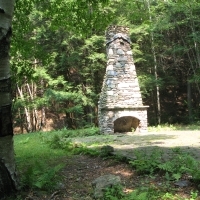 (Host)
(Host)
About half of Vermont’s state parks were established in the 1930s by
the
Civilian Conservation Corps, a New Deal program established by Franklin
Delano Roosevelt. It’s an era of history not widely remembered, but
journalist and commentator Tom Slayton has found plenty of evidence of
it in his
travels to the state parks this summer.
(Slayton) Stone
structures, all across Vermont – stone picnic shelters and restroom
buildings, stone water fountains and fireplaces, roads carved out of
stone or paved with stone, with stone catchbasins for drainage, stone
chimneys still standing long after the buildings they warmed have
collapsed and disappeared – all these and more are the archaeology of
the Civilian Conservation Corps – the CCC – in this state.
President
Franklin D. Roosevelt created the CCC in 1933 and very shortly after
that, Vermont State Forester Perry Merrill, who knew an opportunity when
he saw one, went down to Washington with a list of projects in hand.
The projects were, in the language of construction engineers,
"shovel-ready," and so was Vermont.
Merrill soon had a
not-so-small army of CCC lads working at projects across the state. They
built what became the heart of the State Parks system here – a lot of
it made with stone. And now, about 80 years later, those stone
structures can still be seen in parks across the state. Some, in fact,
are still being discovered.
As Ranger Bill Schreiber made his
rounds at Calvin Coolidge State Park about 10 years ago, he noticed what looked like stone walls or boxes set into the ground along the side of
his park’s roads. Out of curiosity, he dug one out and discovered it was
a drainage catchbasin, originally built by the CCC to capture water
from the  road. Schreiber found other stone catchbasins, dug out the mud
road. Schreiber found other stone catchbasins, dug out the mud
of eight decades, and restored them.
He found several stone fireplaces
and water fountains and restored them, too. And with help from
Americorps volunteers and others, he restored an elegant old picnic
pavilion deep in the forest and cut away some trees to re-open the
hill’s magnificent view of Killington Peak. He later built a
log-cabin-style nature center at the park and dedicated it to his late
wife, Janie. In short, he became a sort of latter day, one-man CCC, and
improved his park – which was originally built by the first CCC – much
in the spirit of his predecessors.
It’s hard to comprehend the
immensity of the Civilian Conservation Corp’s work in Vermont State
Parks. At Little River State Park, for example, just below the huge
earth-fill dam that creates the Waterbury reservoir was located the
largest CCC camp in the East. Earlier this year, park volunteer Ann
Imhoff and I walked for about a mile through the woods, seeing old stone
chimneys, old foundations and wells. The camp just went on and on. It
had churches, a theatre, a hospital, – and was home to more than 3,000
young men who built the huge Waterbury dam.
There were more than
40,000 CCC men in Vermont in the mid-1930s, and they made an immense
impact on this state. Their work has largely been forgotten today, and
very few of the people who visit the parks know their story.
But their legacy lives on. It is written, you might say, in stone.